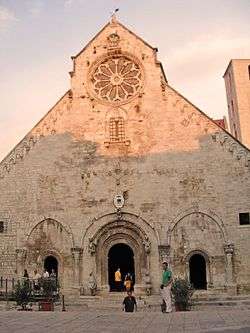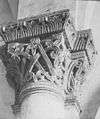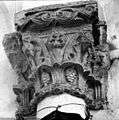Ruvo Cathedral
Ruvo Cathedral (Italian: Concattedrale di Ruvo di Puglia, Concattedrale di Santa Maria Assunta, Duomo di Ruvo di Puglia) is a Roman Catholic cathedral in Ruvo di Puglia, a city in Apulia, southern Italy, dedicated to the Assumption of the Virgin Mary. Formerly the episcopal seat of the Diocese of Ruvo, it is now a co-cathedral in the Diocese of Molfetta-Ruvo-Giovinazzo-Terlizzi. The building is an important example of late Apulian Romanesque architecture, built between the 12th and 13th centuries, with several later alterations.

Description
The current exterior is the result of early 20th-century restoration works which removed the Baroque additions. The church has a sloped façade with three portals: the central and larger one, flanked by two columns standing on lions and surmounted by griphons, has internal reliefs which were once part of an earlier construction. They depict "Christ with the Twelve Apostles", other scenes of the Redeemer's life and plant motifs. The smaller ones, at the sides, have a simpler shape, with two semi-columns supporting ogival arches; they also belonged to previous buildings.
Above the portal is a double mullioned window with a bas-relief of the "Archangel Michael Defeating the Devil", and above it, a 16th-century rose window with twelve radiating columns. This is in turn surmounted by the Sedente ("Sitting One"), an enigmatic figure which has been variously identified as Robert III of Loritello (who funded the construction), while at the top of façade is a statue of the Redeemer. The bell tower, in a different style, most likely formed part of the medieval city's walls.
The interior is divided into a nave and two aisles, ending into three apses, with an orthogonal transept. The nave, like the transept, features a trussed ceiling and, at its sides, has a fake passageway (matroneum) under which are corbels with human, animal or bestial depictions. It stands on two rows of piers, which are each different from another. Some are cruciform, while others are squared; some capitals are sculpted with elements taken from the Christian or medieval mythology, while others feature simpler plant or abstract motifs. The aisles are cross vaulted.
At the end of the nave is a 19th-century ciborium, inspired by that in the Basilica of San Nicola at Bari. Of the chapels added in Baroque or later styles, only two survive: the Chapel of the Sacred Heart (19th-century) and the Chapel of the Holy Sacrament. Artworks include the wooden statue of Saint Blaise, Ruvo's patron saint (16th-century), the silver relic case of the same saint, a panel of the Virgin of Constantinople and a 16th-century wooden crucifix. There are also traces of frescoes, executed by Marco Pino's workshop, depicting the Flagellation of Christ.
The church's subterranean rooms include the remains of a Palaeo-Christian church (5th-6th centuries) and Roman and Peucetian tombs.
Gallery
 1895. Ruvo Cathedral; interior detail of capital. Brooklyn Museum Archives, Goodyear Archival Collection
1895. Ruvo Cathedral; interior detail of capital. Brooklyn Museum Archives, Goodyear Archival Collection 1895. Ruvo Cathedral; interior detail of capital. Brooklyn Museum Archives, Goodyear Archival Collection
1895. Ruvo Cathedral; interior detail of capital. Brooklyn Museum Archives, Goodyear Archival Collection 1895. Ruvo Cathedral; interior detail of capital. Brooklyn Museum Archives, Goodyear Archival Collection
1895. Ruvo Cathedral; interior detail of capital. Brooklyn Museum Archives, Goodyear Archival Collection Ruvo Cathedral; interior looking toward entrance. Brooklyn Museum Archives, Goodyear Archival Collection
Ruvo Cathedral; interior looking toward entrance. Brooklyn Museum Archives, Goodyear Archival Collection
See also
Sources
- Cassano, R. (2001). "La cattedrale di Ruvo". Cattedrali di Puglia – Una storia lunga duemila anni. Bari. p. 154.
| Wikimedia Commons has media related to Cathedral (Ruvo di Puglia). |
External links
- Page at Italian Beni Culturali website (in Italian)
- Page at Ruvo di Puglia museums website (in Italian)